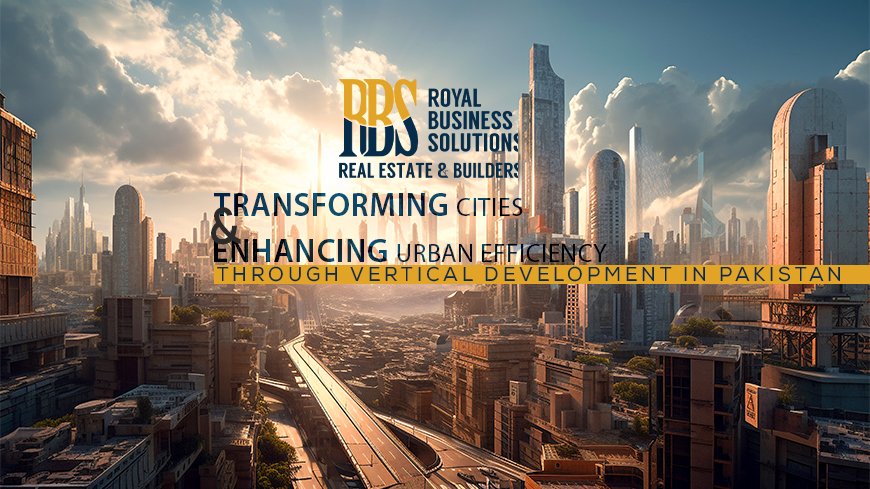- August 21, 2023
- Posted by: Muhammad Shehzad
- Category: Blogs

Introduction
Transforming Cities and enhancing urban efficiency in Pakistan through Vertical developments . The real estate industry is essential to determining the look of cities and promoting economic expansion. Identically, vertical innovations have contributed to a considerable alteration of cities all around the world over time.
Vertical developments, characterized by the construction of tall buildings and skyscrapers but have become a symbol of modern urbanization. Such developments have helped cities maximize their land utilization, accommodate growing populations, and also transform their skylines.
This blog focuses mostly on Pakistan while exploring the beneficial effects of vertical developments on cities around the world. We will also examine the problems caused by horizontal construction and offer ideas to make vertical real estate more appealing to Pakistani homebuyers.
TRANSFORMATION IN CITIES
Urban Density and Infrastructure Optimization
Vertical developments enable cities to make efficient use of limited land resources. By building upwards, cities can accommodate a larger population in a smaller geographical area, reducing urban sprawl. This increased urban density helps optimize infrastructure utilization, leading to improved transportation networks, public services, and utilities.
For example, Dubai, United Arab Emirates, has embraced vertical developments and transformed its skyline into an architectural marvel. The city’s iconic Burj Khalifa stands tall as the world’s tallest building, attracting tourists and driving economic growth.
Economic Growth and Investment Opportunities
Vertical developments contribute to economic growth by attracting investments, creating employment opportunities, and fostering a vibrant real estate market. These developments often serve as mixed-use spaces, incorporating commercial, residential, and recreational facilities, which further spur economic activity. For example, The transformation of New York City’s Hudson Yards showcases the economic potential of vertical developments. This large-scale development has revitalized the area, attracting businesses, tourists, and residents alike.
You can check out the Kohistan Enclave 3.2 Marla on the site if you are looking for a peaceful and relaxed living environment
VERTICAL DEVELOPMENTS IN PAKISTAN
Pakistan, too, has witnessed a growing trend of vertical developments in its major cities. Cities like Karachi, Lahore, and Islamabad are embracing high-rise constructions to meet the rising demand for housing and commercial spaces.
By adopting appropriate strategies, educating the public, and incorporating community-centric features, vertical developments can become more acceptable to homebuyers in Pakistan, leading to sustainable and vibrant cities in the future.
Transforming Cities and enhancing urban efficiency in Pakistan through Vertical developments
Efficient Land Utilization
Vertical developments in Pakistan enable optimal land usage, which is crucial in cities grappling with limited space. These developments can accommodate a larger number of residents, leading to increased population density without sprawling into agricultural or green areas.
Enhanced Infrastructure
Vertical developments in Pakistan promote the efficient use of urban infrastructure, including transportation networks, water and sanitation systems, and energy resources. Concentrating buildings in a smaller area reduces the need for extensive infrastructure expansion, resulting in cost savings and improved service delivery.
Environmental Benefits
Vertical development can have positive environmental impacts. By constructing energy-efficient buildings with modern technologies, cities can reduce their carbon footprint. Additionally, vertical gardens, green roofs, and other sustainable practices can help mitigate urban heat islands and improve air quality.
Affordable Housing
High-rise buildings offer the potential for vertical expansion of housing options, including affordable housing units in prime urban locations. This can help address the housing shortage and provide accommodations for the economically disadvantaged.
Economic Growth
Vertical development can stimulate economic growth by creating opportunities for real estate investment, construction jobs, and the growth of businesses in urban centers.
Reduced Commuting
Vertical development reduces the need for extensive commuting by creating mixed-use neighborhoods where people can live, work, and access services in close proximity. This reduces traffic congestion, air pollution, and the time and stress associated with long commutes.
Property management is a crucial step in any investment if you need any guidance check out 10 Most Important Tips For Property Management In Pakistan
CHALLENGES OF HORIZONTAL DEVELOPMENTS
While horizontal developments have been the traditional approach in Pakistan, they pose certain challenges that can hinder urban efficiency:
Urban Sprawl
Horizontal developments often lead to urban sprawl, where cities expand outward, consuming vast amounts of land. Finally, this can strain infrastructure, increase commuting distances, and lead to environmental degradation.
Inefficient Land Usage
Horizontal developments consume larger land areas per dwelling, due to leading to inefficient land utilization. This inefficiency can result in higher infrastructure costs, increased travel distances, and reduced accessibility to amenities.
Vertical developments have transformed cities worldwide by optimizing land utilization, promoting economic growth, and enhancing urban efficiency. Pakistan can leverage the advantages of vertical real estate to address its urban challenges effectively.
Infrastructure Upgrades:
Many Pakistani cities’ current infrastructure may not be able to support the increase in population brought on by vertical development. Moreover, to adapt to the shifting urban environment, governments, and urban planners must invest in improving roads, utilities, and public transportation networks.
Zoning Restrictions:
To allow for taller structures, outdated zoning restrictions, and building codes may need to be changed. Although, regulations that are more accommodating may encourage developers to fund vertical developments.
Aesthetics and Cultural Context:
Generally, it’s critical to preserve cities’ unique aesthetic and cultural identities. However, to keep the urban fabric grounded, architects and designers must incorporate regional features and traditions into high-rise projects.
Community Engagement:
It is essential that the general public approves of vertical growth. Moreover, its support for these initiatives can be increased by involving neighborhood communities and responding to their issues.
Environmental Impact:
Although vertical growth is environmentally friendly, it must be carefully planned and constructed to reduce any unfavorable effects on the environment, such as wind tunnels and shadows that could harm nearby ecosystems and human comfort.
For investing in real estate, it is difficult to understand how to unlock lucrative opportunities check Kohistan Enclave 3.2 Marla Investing Guide: How To Unlock Lucrative Opportunities?
Conclusion
Transforming Cities and enhancing urban efficiency in Pakistan through Vertical developments. As Pakistan’s urbanization continues to accelerate, the need for innovative solutions to transform cities and also enhance urban efficiency becomes more pressing. Vertical development presents a paradigm shift that can reshape the urban landscape, improve resource management, and also create sustainable and livable cities.
Additionally, by addressing challenges through thoughtful planning, collaboration among stakeholders, and incorporating modern technologies, Pakistan has the potential to harness the power of vertical development to create a brighter future for its cities and citizens. Hence, through a commitment to smart urban planning and a vision of vibrant vertical communities, Pakistan can stand as a shining example of successful urban transformation in the 21st century.
